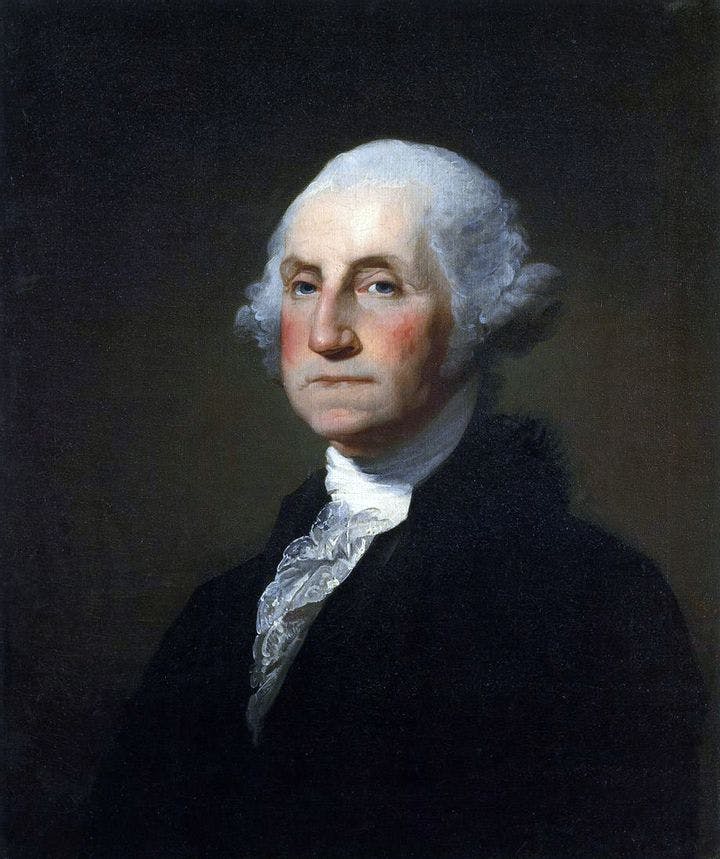Spring 2009
National Subject
– Matthew Battles
Matthew Battles on early American art.
In the 18th and early 19th centuries, many Americans saw no place for art in their new nation. The country lacked professional art academies, patrons who commissioned work for palaces and cathedrals, and the leisure to appreciate art. In fact, however, this new land presented painters and sculptors with a host of opportunities. Wealthy colonists wanted their portraits limned; they lined their studies with paintings and ornaments. And, as Hugh Howard shows in The Painter’s Chair, post-colonial America’s political culture called on a generation of artists to develop new means of representing history, power, and achievement.
The painter’s chair of Howard’s title is no mere stool or Windsor armchair, but a technical apparatus—a seat on gimbal and screw—that permitted the artist to revolve a sitter without altering his pose as the light changed throughout the day. George Washington became intimately familiar with the chairs of many artists. By Howard’s count, Washington sat for at least 28 painters, several of them on numerous occasions. The resulting portraits were endlessly reproduced. Despite his frequent expressions of impatience, Washington keenly understood the manifold purposes of the visual arts in his time—to provide a record of people and events, mementos of loved ones, and the images that helped form public discourse and popular mythology.
Whether Washington was sitting for artists or presiding over the Constitutional Convention, his impassive countenance belied a sensitive apprehension of events. One of Howard’s most delightful scenes, in which Washington lies on a large table at Mount Vernon breathing through quills in his nostrils while the sculptor Jean-Antoine Houdon trowels his face with warm plaster, is described by the subject himself. The first president recorded the procedure in his journal with plainspoken precision, noting that the process began with pieces of gypsum broken into lumps “the size of a pullets egg,” and that the plaster was ready to apply to his face when “made as thick as Loblolly or very thick cream.”
Howard, who has written extensively about the Founding Fathers’ attitudes toward architecture, has produced in The Painter’s Chair a serious work of art history. Alternating Washington’s turns in the chair with episodes in the lives of painters such as John Trumbull and Gilbert Stuart, he shows us how the course of human events in the young nation helped to break new ground in image-making as well. Paintings that might appear stodgy and stale to the modern eye were innovative in their time. By depicting General James Wolfe’s death in the 1759 Battle of Quebec in a realist style, for instance, showing soldiers and officers in contemporary dress rather than classical attire, Benjamin West broke with convention and caused a sensation in London. That painting paved the way for West’s pupil John Trumbull to depict the signers of the Declaration of Independence in the same fashion. But Trumbull’s painting took innovation a step further, Howard argues, by treating the signing of a document as an occasion as momentous as a battle. Trumbull’s work cast the Enlightenment occupation of political thinking in heroic mode. “Although it records a legislative moment rather than a military confrontation,” Howard writes of the painting that bears the name of this founding document, “The Declaration of Independence would ring out over the centuries louder than a cannon shot.”
Howard’s story turns melancholy after Washington’s death, as the next generation of artists contends with the deepening complexities of life in the new Republic. Rembrandt Peale, troubled son of the Revolutionary War figure and portraitist Charles Peale, painted the elderly Washington in 1795 as a fragile paterfamilias. Many years later, the younger Peale produced another portrait of the father of the country. In Patriae Pater, which hangs in the U.S. Capitol, we see a vigorous Washington framed in a heavy stone porthole festooned with graven oak leaves and the head of Jupiter. Peale had returned to the classicism eschewed by his father’s generation, but it’s a twisted classicism, bathed in shadows and crepuscular light. The painting glowers with romantic intensity. Between us and glory stands history, cold and immobile as stone. It’s as if we’re looking through the oculus of a mausoleum—yet it’s impossible to tell whether the tomb is Washington’s or our own.
* * *
Matthew Battles writes regularly for the Ideas section of The Boston Globe. He is the author of Library: An Unquiet History (2003) and is at work on a book about the history of writing.
Reviewed: The Painter's Chair: George Washington and the Making of American Art by Hugh Howard, Bloomsbury, 297 pp, 2009.
Image courtesy of Wikimedia Commons
Up next in this issue
